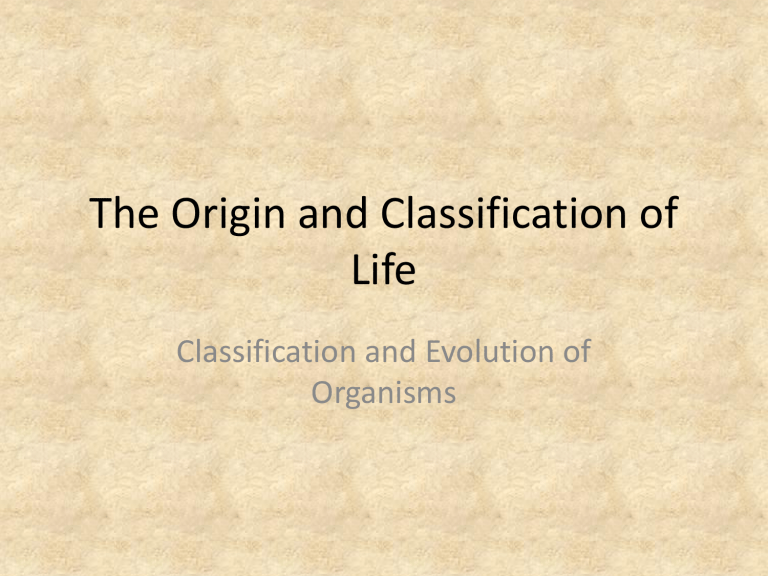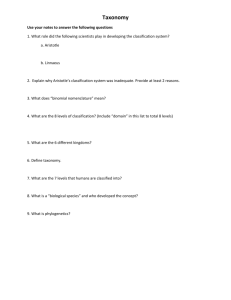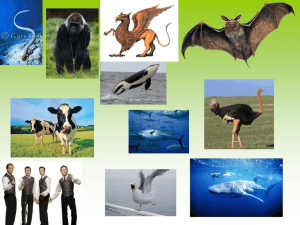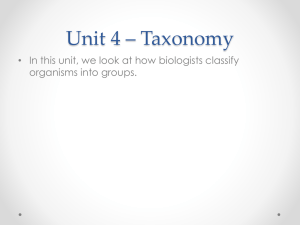The Origin and Classification of Life

The Origin and Classification of
Life
Classification and Evolution of
Organisms
Taxonomy
• Taxonomy is the science of naming organisms and grouping them into categories.
• Derived from the Greek word taxis, which means arrangement.
Binomial System of Nomenclature
• The binomial system of nomenclature was developed by Carolus Linnaeus in 1758.
• The system uses only two latin names – the genus and the specific epithet for each species of organism.
Carolus Linnaeus
Binomial System of Nomenclature
• A species is a population of organisms capable of interbreeding and producing fertile offspring.
• A genus is a group of closely related organisms.
Hierarchy of Classification
Domains
• A Domain is the largest category of organisms.
• There are three main domains: Eubacteria,
Archaea, and Eucarya.
• The Eubacteria and Archaea are prokaryotic and the Eucarya are eukaryotic.
Domains of Life
Kingdom
• A kingdom is a subdivision of a domain.
• There are several kingdoms within the
Eubacteria and Archaea based primarily on differences in the metabolism and genetic composition of the organisms.
Kingdom
• There are four kingdoms within the Domain
Eucarya.
– Plantae
– Animalia
– Fungi
– Protista (protozoa and algae)
Kingdoms
Phylum
• A phylum is a subdivision of a kingdom.
• Organisms are based into phyla based upon careful investigation of their structure, metabolism, and biochemistry.
Phylum
• An attempt is made to classify natural groups rather than imposing artificial subdivisions.
• Only flowering plants produce flowers and have seeds; conifers lack flowers but have seeds in cones; ferns lack flowers, cones, and seeds; and mosses lack tissues for transporting water.
Class
• A class is a subdivision within a phylum.
• Within the phylum Chordata within the the kingdom Animalia, there are seven classes: mammals, birds, reptiles, amphibians, and three classes of fish.
Order
• An Order is a category within a class.
• The order Carnivora is an order of meat-eating animals within the class Mammalia.
Family
• A Family is a subdivision of an order that consists of a group of closely related genera, which in turn are composed of closely related
species.
Family
• The cat family, Felidae, is a subgroup of the order Carnivora; it includes many species in several genera, including the Canada lynx and bobcat (genus Lynx); the cougar; the leopard, tiger, jaguar, and lion (genus Panthera); the house cat (genus Felis); and several other genera.
All Life On Earth
Kingdom: Animalia
Phylum: Chordata
Class: Mammalia
Order: Rodentia
Family: Sciuridae
Genus: Sciurus
Species: Vulgaris
Taxonomic
Category
Domain
Kingdom
Phylum
Classification of Humans
Human
Classification
Eucarya
Animalia
Chordata
Characteristics
Cells containing a nucleus and other organelles
Eukaryotic heterotrophs, usually motile, specialized tissues
Stiffening rod down back
Other
Representatives
Plants, animal, fungi, protozoa, algae
Sponges, jellyfish, worms, clams, insects, snakes, ctas
Fish, amphibians, reptiles, birds, mammals
Taxonomic
Category
Class
Order
Family
Classification of Humans
Human
Classification
Mammalia
Primates
Hominidae
Characteristics
Hair and mammary glands
Relatively large brain and opposable thumb
Primates that lack a tail and have an upright posture
Other
Representatives
Kangaroos, mice, whales, skunks, monkeys
Monkeys, gorillas, chimpanzees, baboons
Humans and extinct relatives
(australopithecus,
Paranthropus,
Homo)
Taxonomic
Category
Genus
Species
Classification of Humans
Human
Classification
Homo
Homo Sapiens
Characteristics
Hominids with large brains
Other
Representatives
Humans are the only surviving member of the genus (past members: homo erectus, homo neanderthalensis)
Humans
Phylogeny
• Phylogeny is the science that explores the evolutionary relationships among organisms, seeking to reconstruct evolutionary history.
• Taxonomists and phylogenists work together, so that the products of their work are compatible.
Evidence Used to Establish
Phylogenetic Relationships
• Several lines of evidence are used to develop evolutionary histories: fossils, comparative anatomy, life cycle information, and biochemical and molecular evidence.









